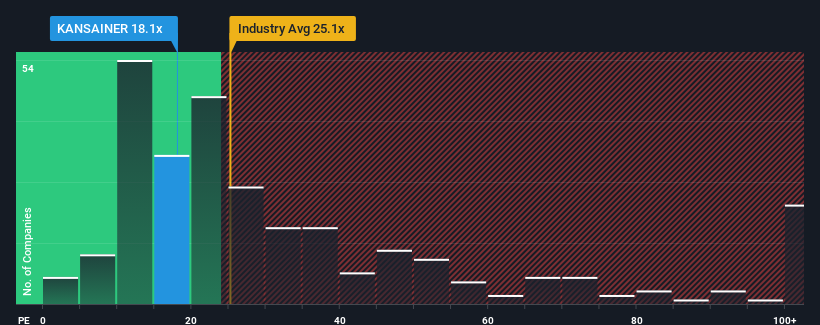Little Excitement Around Kansai Nerolac Paints Limited's (NSE:KANSAINER) Earnings

Kansai Nerolac Paints Limited's (NSE:KANSAINER) price-to-earnings (or "P/E") ratio of 18.1x might make it look like a buy right now compared to the market in India, where around half of the companies have P/E ratios above 27x and even P/E's above 51x are quite common. However, the P/E might be low for a reason and it requires further investigation to determine if it's justified.
We've discovered 3 warning signs about Kansai Nerolac Paints. View them for free.Kansai Nerolac Paints hasn't been tracking well recently as its declining earnings compare poorly to other companies, which have seen some growth on average. It seems that many are expecting the dour earnings performance to persist, which has repressed the P/E. If you still like the company, you'd be hoping this isn't the case so that you could potentially pick up some stock while it's out of favour.
See our latest analysis for Kansai Nerolac Paints

How Is Kansai Nerolac Paints' Growth Trending?
Kansai Nerolac Paints' P/E ratio would be typical for a company that's only expected to deliver limited growth, and importantly, perform worse than the market.
Retrospectively, the last year delivered a frustrating 1.1% decrease to the company's bottom line. However, a few very strong years before that means that it was still able to grow EPS by an impressive 151% in total over the last three years. Accordingly, while they would have preferred to keep the run going, shareholders would probably welcome the medium-term rates of earnings growth.
Shifting to the future, estimates from the analysts covering the company suggest earnings growth is heading into negative territory, declining 39% over the next year. That's not great when the rest of the market is expected to grow by 25%.
With this information, we are not surprised that Kansai Nerolac Paints is trading at a P/E lower than the market. Nonetheless, there's no guarantee the P/E has reached a floor yet with earnings going in reverse. Even just maintaining these prices could be difficult to achieve as the weak outlook is weighing down the shares.
What We Can Learn From Kansai Nerolac Paints' P/E?
We'd say the price-to-earnings ratio's power isn't primarily as a valuation instrument but rather to gauge current investor sentiment and future expectations.
We've established that Kansai Nerolac Paints maintains its low P/E on the weakness of its forecast for sliding earnings, as expected. At this stage investors feel the potential for an improvement in earnings isn't great enough to justify a higher P/E ratio. Unless these conditions improve, they will continue to form a barrier for the share price around these levels.
It's always necessary to consider the ever-present spectre of investment risk. We've identified 3 warning signs with Kansai Nerolac Paints (at least 1 which is concerning), and understanding them should be part of your investment process.
If P/E ratios interest you, you may wish to see this free collection of other companies with strong earnings growth and low P/E ratios.
Valuation is complex, but we're here to simplify it.
Discover if Kansai Nerolac Paints might be undervalued or overvalued with our detailed analysis, featuring fair value estimates, potential risks, dividends, insider trades, and its financial condition.
Access Free AnalysisHave feedback on this article? Concerned about the content? Get in touch with us directly. Alternatively, email editorial-team (at) simplywallst.com.
This article by Simply Wall St is general in nature. We provide commentary based on historical data and analyst forecasts only using an unbiased methodology and our articles are not intended to be financial advice. It does not constitute a recommendation to buy or sell any stock, and does not take account of your objectives, or your financial situation. We aim to bring you long-term focused analysis driven by fundamental data. Note that our analysis may not factor in the latest price-sensitive company announcements or qualitative material. Simply Wall St has no position in any stocks mentioned.
About NSEI:KANSAINER
Kansai Nerolac Paints
Manufactures and supplies paints and varnishes, enamels, and lacquers in India.
Flawless balance sheet established dividend payer.
Similar Companies
Market Insights
Community Narratives




